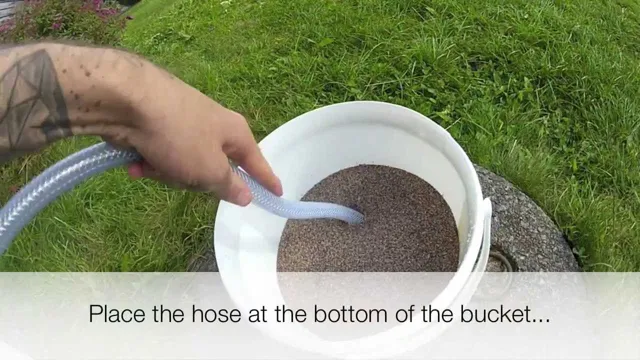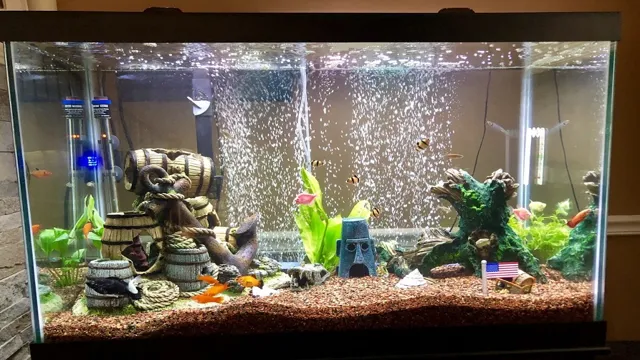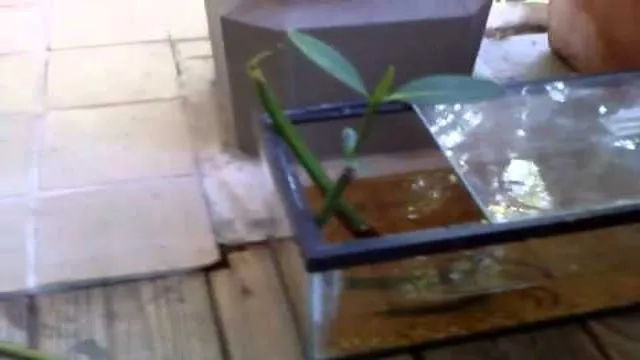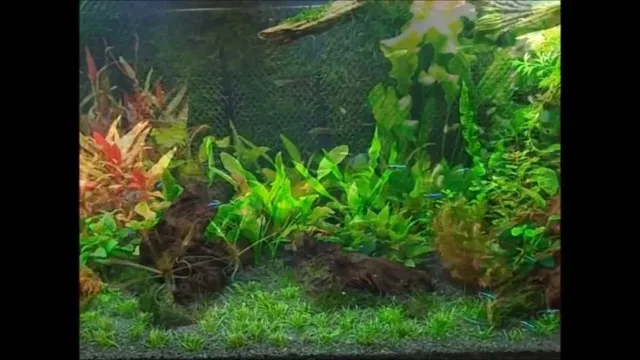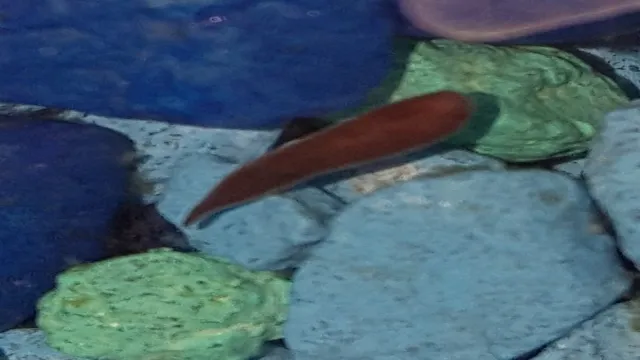Keeping a saltwater aquarium is a very rewarding hobby, but it also requires a lot of effort and responsibility. One of the most important tasks for any aquarium owner is keeping the tank clean and well-maintained. This not only ensures the health and happiness of your fish and other aquatic creatures, but it also keeps the tank looking its best.
One popular method for cleaning a saltwater aquarium is using sand as the substrate. Not only does sand provide a natural and visually pleasing look for the tank, but it also serves as a great filtering tool. In this blog, we’ll take a look at how to effectively clean a saltwater aquarium with sand, to ensure your tank stays healthy and beautiful for years to come.
Gather Required Items
When it comes to cleaning a saltwater aquarium with sand in it, gathering the required items is the first step to take. Here’s what you’ll need: a siphon hose, a bucket, a scraper or algae pad, a clean cloth or paper towel, and a glass cleaner. Once you have all of these items, you can begin the cleaning process.
It’s essential to ensure that all the equipment you use is clean and free of any chemicals or residue that could harm the fish or the water quality. You’ll be using the siphon hose to remove debris and waste from the sand bed while allowing clean water to return to the aquarium. The scraper or algae pad is used to clean the sides of the glass or acrylic tank.
The glass cleaner is crucial for cleaning the outside of the tank, removing any fingerprints or smudges that may be obstructing your view. By gathering these items, you’re one step closer to achieving a clean and healthy environment for your saltwater aquatic pets.
Bucket and Siphon
When it comes to bottling homebrewed beer or cider, a bucket and siphon are essential tools to transfer your brew from one container to another without oxidizing it. To gather the required items, you’ll need a food-grade plastic bucket with a spigot at the bottom, usually sold as a bottling bucket, and a siphon tube with a racking cane attached to one end and a clip to hold it in place at the other. You’ll also need a bottle filler attachment that fits on the end of the siphon, making it easier to control the flow and reduce spills.
Before starting the bottling process, sanitize all equipment, including bottles, caps, and any utensils used in the process, to avoid contamination. With the right tools and a bit of practice, bottling your own beer or cider can be a fun and satisfying experience, providing a sense of pride with every sip.
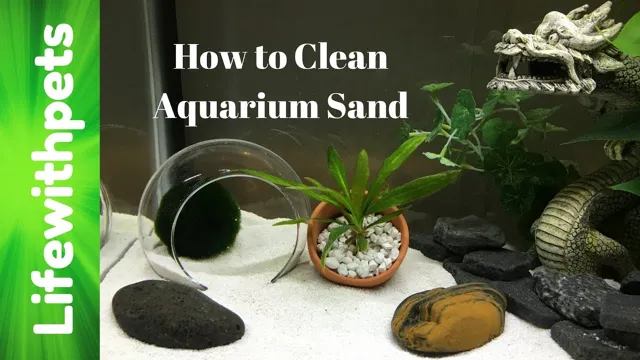
Filter Media Bag
If you’re looking to optimize your aquarium’s filtration system, a filter media bag is a great addition to your setup. To get started, you’ll need a few items to create your own custom filter media bag. Firstly, you’ll need a mesh bag, commonly made of nylon or polyester, to hold the filter media.
You can find these bags at most pet stores or online retailers. Secondly, choose the type of filter media you want to use, such as activated carbon, ceramic rings, or bio-balls, depending on the needs of your aquarium. Lastly, consider adding a strapping or tie to the bag to make it easier to place and remove from your filtration system.
Once you have these items, you’re ready to assemble your filter media bag and enjoy cleaner, clearer water for your aquatic pets.
Aquarium Salt Mix (Optional)
If you’re considering setting up an aquarium, you may want to consider using an aquarium salt mix. While not necessary for all aquariums, a salt mix can be helpful for fish that require a certain level of salinity in their environment. Before adding anything to your aquarium, it’s important to gather all the necessary items.
For an aquarium salt mix, you’ll need to purchase the mix itself, which can typically be found at pet stores or online. You’ll also want to ensure you have a good testing kit to measure the salinity level in your tank, as well as a hydrometer or refractometer to accurately measure the salinity levels. Once you have all the necessary items, you can start creating the optimal environment for your fish.
Remember to always read up on the specific needs of your fish species to ensure a healthy, happy existence for your aquatic pets.
Clean Water
When it comes to clean water, there are a few essential items you’ll need to gather to ensure that your drinking water is safe and healthy. The first thing you’ll need is a water filter. Water filters can remove impurities from your drinking water, such as bacteria, chlorine, and other harmful contaminants.
There are many different types of water filters available, including activated carbon filters, reverse osmosis filters, and UV filters. You’ll need to choose the type of filter that works best for your particular needs and budget. In addition to a water filter, you’ll also need to gather a container to hold your filtered water.
Glass or stainless steel containers are ideal, as they won’t leach any chemicals into your water. By gathering these essential items, you’ll be well on your way to drinking clean, healthy water.
Prepare Aquarium for Cleaning
If you have a saltwater aquarium with sand in it, it’s crucial to keep it clean to ensure that the tank’s inhabitants remain healthy and happy. The first step in cleaning your aquarium is to prepare the tank. Begin by removing anything in the tank that can be safely taken out, such as decorations or plants, and place them in a safe spot.
Turn off all equipment, such as filters and heaters, to prevent any accidents during the cleaning process. Once everything is removed and turned off, you can then begin siphoning the water from the tank into a large bucket or sink using a siphon hose. It’s important to be gentle throughout this process, as you don’t want to disturb the sand bed.
After siphoning off as much water as possible, use a clean sponge or scraper to remove any algae or debris from the glass and other surfaces. Finally, carefully put everything back into the tank and begin refilling it with clean saltwater. By following these simple steps, your saltwater aquarium with sand in it will be clean, healthy, and a delight to look at.
Turn off All Equipment
Before starting the process of cleaning your aquarium, it’s incredibly important to turn off all equipment. This will ensure that no harm comes to your fish, and that the cleaning process will be as safe as possible. Before you begin, make sure to double check that all filters, heaters, lights, and any other equipment is off. (See Also: How Thick Should Acrylic Aquarium Be? A Comprehensive Guide)
You don’t want to risk any electrical accidents while cleaning. Once you’ve made sure everything is off, the next step is to start preparing your aquarium for cleaning. This might include removing any decorations, plants, or other objects that are in the way.
It’s important to do this carefully and gently, as you don’t want to upset the balance of the aquarium. With a bit of patience and care, you can prepare your aquarium for cleaning and get it looking great in no time.
Remove and Clean Decorations, Rocks, and Plants
Aquarium Cleaning Before you start the cleaning process of your aquarium, you need to prepare it properly. The first step is to remove all the decorations, rocks, and plants. This will provide you with ample space to clean the aquarium properly.
You can clean the decorations, rocks, and plants in a separate container to remove any dirt or impurities. If you are using plastic plants, you can wash them with water and mild soap. However, if you are using live plants, you need to handle them delicately to avoid damaging them.
Use a soft brush or your fingers to remove any dirt or algae from the plants. Also, check the rocks for any debris or algae growth and use a brush to remove them. Once you remove all the decorations, rocks, and plants, you can proceed to clean the aquarium.
But before that, you need to turn off all the equipment, including the filter, heater, and lights. This is to ensure your safety while cleaning the aquarium. It is essential to clean your aquarium often, as it directly impacts the health of your fish.
Cleaning your aquarium once a month is sufficient, but if you have a heavily stocked tank, you might need to clean it more frequently. In conclusion, removing and cleaning decorations, rocks, and plants is crucial before cleaning your aquarium. Make sure you handle live plants delicately and check rocks for debris or algae growth.
Also, turn off all equipment before starting the cleaning process to ensure your safety. Regular cleaning of your aquarium will not only keep it hygienic but also improve the overall health of your fish.
Remove about 25% of the Water
When it comes to cleaning your aquarium, the first step is to remove around 25% of the water. This will allow you to access the bottom of the tank and remove any debris or build-up that has settled there. However, it’s important to prepare the aquarium before doing so.
Firstly, turn off all equipment including heaters, pumps, and filters. Then, unplug any electrical devices and remove any decorations or plants from the tank. Next, use a clean sponge or scraper to remove any debris or algae from the sides of the tank.
Once you’re ready, use a siphon to remove the water while taking care not to disturb the substrate or fish too much. This will ensure that any excess food, poop, or other waste is removed without causing unnecessary stress to your fish. After removing the water, you can start cleaning the rest of the tank before adding fresh, clean water and turning the equipment back on.
By following these simple steps, you’ll have a clean and healthy aquarium where your fish can thrive.
Cleaning the Sand
If you have a saltwater aquarium with sand in it, cleaning the sand is an important aspect of maintaining a healthy environment for your fish and other aquatic life. One way to clean the sand is to use a gravel or sand vacuum to remove built-up debris and uneaten food. Begin by turning off all equipment and letting the water settle for a few minutes.
Then, carefully place the vacuum in the sand and poke it into the surface to stir up any waste. Slowly and methodically move the vacuum over the entire surface of the sand, being careful not to vacuum up any small animals or plants living in the sand. Be sure to empty the contents of the vacuum into a bucket or sink before discarding it.
Repeat this process until the sand is clean and free of debris. Regular cleaning of the sand will keep your saltwater aquarium healthy and thriving.
Vacuum Sand Surface with Siphon
Vacuum Sand Surface with Siphon – Cleaning the Sand Are you tired of a dirty and unattractive sand surface in your backyard? You can easily clean it with a vacuum sand surface with siphon, which is a simple and effective method. This cleaning method eliminates the need for any chemicals, brushes, or rinsing. All you need is a siphon sand vacuum and a filter bag.
Begin by attaching the siphon sand vacuum to a garden hose. Once this is done, lower the siphon into the sand, ensuring that the suction tip is buried about 1 inch deep in the sand. You should start seeing dirt and debris being sucked up through the hose.
Keep the siphon moving, making sure you cover the whole area and reach every nook and cranny. The filter bag is essential as it traps the debris that has been collected through the siphon. Be sure to check the bag regularly and empty it once it’s full to prevent the debris from going back into the sand. (See Also: How to Get Snail Eggs off Aquarium Plants: The Ultimate Guide)
You can repeat the process until the sand is feeling fresh and clean. In conclusion, keeping the sand surface clean has never been as easy as with vacuum sand surface and siphon. This method is cheap, easy to use, and does not involve the use of any harmful chemicals.
You can create a beautiful and attractive backyard for your family and friends by following this simple cleaning process. Give it a try!
Clean the Sand bed with Filter Media Bag to remove Dirt and Debris
When it comes to maintaining a clean and healthy aquarium environment, cleaning the sand bed is an essential part of the process. Over time, debris and waste can accumulate in the sand, affecting the water quality and potentially harming your fish. That’s where a filter media bag can come in handy! Simply fill the bag with some of your filter media, such as filter floss or activated carbon, and place it in the sand bed.
The bag will catch any dirt and debris as water flows through it, leaving your sand bed sparkling clean. This method is much more efficient than traditional siphoning methods which can stir up the sand bed and cause more harm than good. By taking the time to clean your sand bed with a filter media bag, you’ll be helping to provide a healthy and happy home for your aquatic friends.
Refilling the Aquarium
If you’re wondering how to clean a saltwater aquarium with sand in it, refilling the aquarium is a crucial step in the process. First, you’ll want to use a siphon to remove any debris and dirt that may have accumulated in the sand. This will help ensure that the sand stays clean and doesn’t become a breeding ground for harmful bacteria.
Once the sand is clean, start refilling the aquarium slowly with fresh saltwater. Be sure to add water slowly so that you don’t disturb the sand bed. Once the aquarium is filled, give it some time to settle in before adding any fish or other marine animals.
This will allow the sand to settle and any trapped air bubbles to escape. Remember to monitor the water temperature, salinity, and pH levels to ensure a healthy and safe environment for your marine pets. With these steps, you can easily maintain a clean and healthy saltwater aquarium with sand.
Fill the Aquarium with Clean Water and Add New Salt Mix (Optional)
When refilling your aquarium, it is important to start with clean water. Not only does this eliminate any harmful toxins that may have built up in your tank, but it also provides a clear canvas for reintroducing your marine life. If you are using a saltwater aquarium, you have the opportunity to add new salt mix to ensure an optimal balance of minerals.
While this step is optional, it has the potential to improve the overall health and well-being of your aquatic creatures. When adding new water and salt mix, be sure to maintain the appropriate temperature and salinity levels to avoid any shock to your marine life. With patience and attention to detail, you can successfully refill your aquarium and create a fresh environment for your beloved pets.
Set Up Aquarium Equipment and Reintroduce Decorations, Rocks, and Plants
Once you have thoroughly cleaned your aquarium, it’s time to refill it with water. Before adding any water, make sure all the equipment such as filters, heaters, and air pumps are properly set up. Fill the aquarium with water slowly to prevent any damage to the bottom or sides of the tank.
It is important to treat the water with a good quality water conditioner to remove any harmful chemicals before adding it to the aquarium. Once the water is added, it is time to reintroduce the decorations, rocks, and plants. Spend some time placing the decorations in a manner that is visually appealing, and make sure you leave enough room for your fish to swim around.
Adding some live plants can also help purify the water and provide a natural environment for your fish. By following these simple steps, you can set up your aquarium equipment and reintroduce all the necessary items to create a healthy and beautiful aquatic environment for your fish to thrive in.
Maintaining a Clean Saltwater Aquarium with Sand
When it comes to maintaining a clean saltwater aquarium with sand, there are a few key steps that you should follow. First and foremost, it’s important to regularly clean and replace your sand substrate. This will ensure that any waste and debris is removed from the tank, preventing it from building up and creating harmful conditions for your fish and other aquatic creatures.
You’ll also want to vacuum the sand to remove any uneaten food or other debris that may have accumulated. In addition to cleaning the sand, it’s important to maintain proper water chemistry and filtration in your aquarium. Regular water changes and the use of a good protein skimmer can help keep the water clear and free of harmful toxins.
And, of course, it’s important to monitor your aquarium regularly for signs of illness or other problems, so that you can take action before they become serious. Overall, with a little effort and attention to detail, it’s possible to maintain a beautiful and healthy saltwater aquarium with sand substrate.
Regular Water Changes
One of the most important aspects of maintaining a clean saltwater aquarium with sand is regular water changes. It is essential to keep the water fresh and free of harmful chemicals or pollutants that can accumulate over time. By changing a portion of the water on a regular basis, you can remove any excess waste, uneaten food, or other debris that may have settled on the sand bed.
This can help prevent the build-up of harmful bacteria or algae, which can impact the health of your fish and other marine life. Regular water changes also help to maintain stable water parameters and promote the growth of beneficial bacteria that can aid in the breakdown of organic waste. Overall, investing time and effort in regular water changes can go a long way in keeping your aquarium healthy and thriving.
Maintain Proper Water Chemistry
Maintaining a clean saltwater aquarium with sand demands proper water chemistry. It’s significant to keep in mind that sand not only makes the aquarium look beautiful but also does the job of a natural filter by collecting debris and waste. It becomes dangerous if the sand detritus isn’t cleaned regularly; the organism living in the aquarium could be harmed.
To maintain proper water chemistry for a clean saltwater aquarium with sand, you should test the water regularly, maintain proper pH levels and salinity levels. Always remember to replace the water regularly to prevent an accumulation of toxic waste that could be fatal to the organisms. Using a protein skimmer for the aquarium is highly recommended. (See Also: How to Make Powerheads on Aquarium Not Visible: Tips and Tricks)
It helps in removing uneaten food, fish excrement, and other waste products. Calcium and alkalinity are equally essential in maintaining proper water chemistry. It would be best to use a calcium buffer to maintain the alkalinity levels.
Failure to keep the right water chemistry balance could lead to the death of your aquarium’s inhabitants.
Monitor and Clean the Sand Bed Regularly
Maintaining a clean saltwater aquarium with sand requires regular monitoring and cleaning of the sand bed. The sand bed in a saltwater aquarium is a crucial component of the tank’s filtration system as it is a home to beneficial bacteria that help break down waste and keep the water clean. However, if the sand bed becomes overwhelmed with debris, it can produce harmful chemicals that can harm the inhabitants of the tank.
Therefore, it is vital to regularly check and clean the sand bed to ensure it remains healthy. One way to monitor the sand bed’s health is to observe the color and texture of the sand. If the sand starts to turn brown or gray and feels gritty to the touch, it could indicate a buildup of waste and detritus.
In this case, it is necessary to use a siphon to clean the sand bed and remove any debris. It is also essential to ensure that the sand bed is not too shallow, allowing waste to accumulate and harm the bacteria. Similarly, a sand bed that is too deep can prevent proper water flow and oxygenation, leading to poor water quality.
Maintaining a clean saltwater aquarium with sand requires dedication and effort, but it is crucial to the health and longevity of the tank’s inhabitants. Just like cleaning your home, keeping up with simple maintenance tasks like regular cleaning of the sand bed can prevent more significant problems down the road. So, next time you’re admiring your beautiful saltwater aquarium, don’t forget to show your sand bed some love, too!
Conclusion
Cleaning a saltwater aquarium with sand in it may seem like a daunting task, but with the right tools and technique, it can be a breeze. Just remember to keep a close eye on your water parameters and perform routine maintenance regularly. And if all else fails, just pretend that the sand is really tiny cleaning robots doing all the work for you.
Happy cleaning!”
FAQs
What is the best way to clean a saltwater aquarium with sand in it?
The best way to clean a saltwater aquarium with sand in it is by using a siphon or a gravel vacuum to remove debris and waste from the sand bed. It’s important to be gentle while cleaning to avoid disrupting the sand bed and harming any beneficial bacteria that may be present.
Can I clean my saltwater aquarium with sand in it without removing the sand?
Yes, you can clean your saltwater aquarium with sand in it without removing the sand. Use a siphon or gravel vacuum to remove debris and waste from the sand bed as gently as possible. It’s also a good idea to rinse the sand with a hose to remove any excess debris.
How often should I clean my saltwater aquarium with sand in it?
It’s recommended to clean your saltwater aquarium with sand in it once a week or every other week. However, the frequency of cleaning may vary depending on the size of your tank, the number of inhabitants, and the level of waste produced.
Can I use bleach to clean my saltwater aquarium with sand in it?
No, bleach should never be used to clean a saltwater aquarium with sand in it. Bleach is toxic to fish and can harm any beneficial bacteria present in the tank. Instead, use a siphon or gravel vacuum to remove debris and waste from the sand bed.
How can I prevent sand from getting into my aquarium equipment while cleaning?
To prevent sand from getting into your aquarium equipment while cleaning, turn off all the equipment and remove any attachments that may collect sand. Hold the siphon or gravel vacuum slightly above the sand bed while cleaning to avoid stirring up the sand.
Can I add new sand to my saltwater aquarium without removing the old sand?
It’s not recommended to add new sand to a saltwater aquarium without removing the old sand. The existing sand bed can accumulate toxins and excess waste that may harm your fish. It’s best to completely replace the sand bed every few years.
Are there any alternative methods to clean a saltwater aquarium with sand in it?
Yes, you can also use a mechanical filter or a protein skimmer to remove debris and waste from the water column. However, it’s still important to use a siphon or gravel vacuum to clean the sand bed to avoid buildup of waste and toxins.

